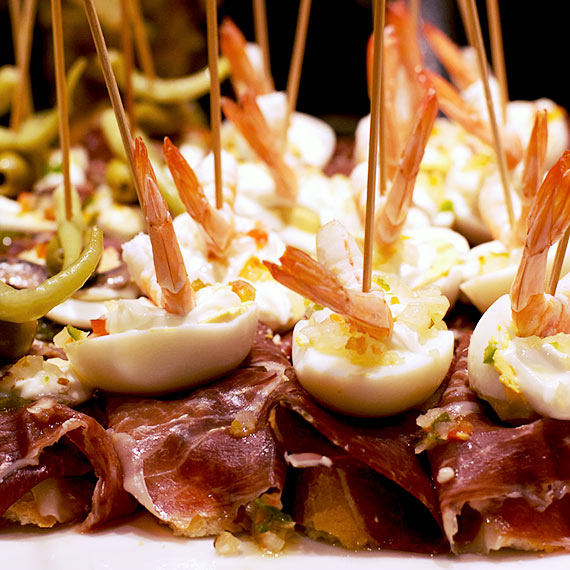Spain

Anyone who thinks of Spain only as the land of flamenco, bullfighting (olé!), and Antonio Banderas (or, if you prefer, Penélope Cruz) might be surprised to learn the place is surprisingly diverse in a variety of different ways. This largest country in southern Europe, located on the Iberian Peninsula, spans an area in size about halfway between Texas and California and across its 17 autonomous regions, the geography and cuisine vary greatly. (As far as climate goes, in case you were wondering, My Fair Lady’s “the rain in Spain stays mainly in the plain” is only a song title.) Spain borders France, Portugal, Andorra, Gibraltar, and notably, is the only European country to share a border with one in Africa (Morocco). All of these influences, and more, are present in the local cuisine.
In honor of one of tonight’s featured restaurants, Salero on West Randolph, here is a bit more about the food you’ll find in the vibrant country sometimes called “La Furia Roja” (The Red Fury), which also refers to Spain’s national football team.
First, anyone who has traveled there or checked out the menu in a Spanish restaurant has seen tapas or pintxos, and possibly montaditos. All are “small plates” or appetizers (although, as with all appetizers, you can certainly make a great meal out of them if you order enough!). Given the traditionally long period between luncheon and dinner, these can often tide you over in a similar fashion to afternoon tea in other countries. But how do they differ from each other?
- Tapas: the name is derived from the Spanish word “tapar,” which means “to cover.” Its origins are unclear, but The Joy of Cooking theorizes that “the first tapas were slices of bread or meat used to cover glasses of sherry…to prevent fruit flies from hovering.” In those days, these were included free with the drinks, something that is generally not true today. Another story (which still makes sense) is that tapas were served with alcohol to slow down the patrons’ intoxication process (reminiscent of that “happy hour” buffet). Today, tapas can include almost anything that is available regionally — combinations of tuna, cod, mussels, squid; ham, meatballs, chorizo; omelette, olives, peppers — seasoned with a wide variety of spices, including paprika, garlic, chilies, and others.
- Pintxos (pronounced PEEN-chos): most popular in the Basque region in Northern Spain, the English translation of the name is “spike,” probably in reference to a cocktail stick or skewer that is used to affix its ingredients (meats, vegetables, olives, cheeses, fish) to a small piece of baguette-like bread. These should be easy consumable in one bite (after removing the skewer, of course). Like tapas, they are very popular in cafes and bars, and are meant to be enjoyed in the company of others in a social setting.
- Montaditos: which means, fittingly, “small sandwich” in English, are exactly that…served open-faced on toast, without the signature skewer you would find in pintxos.
Here are some other standards:
- Empanadas: small pastries stuffed with meat, seafood, and other fillings, similar to those popular in Argentina.
- Paella: a popular Spanish stew, prepared in a distinctive large shallow frying pan (this is where the dish gets its name), composed of chicken, shellfish, vegetables, saffron and other spices, simmered with rice. If you have a slow cooker at home, this is an ideal use for it, but it’s also traditionally shared with others while dining out.
- Gazpacho: This cold soup, often served in the U.S., originated in Andalusia — the hot, arid southern region of Spain. Understandably, it is very popular in summer. There are many different kinds, but the most familiar variety has a tomato base.
- Beverages: What is best to imbibe with all of this? With such a wide variety of ingredients, wine pairings can be challenging, but you can’t go wrong with (of course) a Spanish wine such as a dry Rosado (spicy rosé); cava, Spain’s version of sparkling wine; Rioja and Ribera del Duero (reds); Albariño (white), and, coming full circle, sherry.
- Dessert: If you still have room for it, there is flan, a firm vanilla-caramel custard also popular in Mexican restaurants; tarta de queso, Spanish cheesecake, which is generally lighter than the New York variety, usually topped with berries; crema catalona, the Spanish incarnation of crème brulée; churros, tubes of fried dough served with melted chocolate; Miguelitos, which are similar to Greece’s baklava but filled with chocolate ganache; and Spain’s famous Easter dessert, torrijas, which are essentially small pieces of French toast with milk and cinnamon, drenched in honey or wine.
Miguelito
Whether you dine at Salero, Cafe Iberico, or any of the Chicago area’s other great Spanish/tapas restaurants, you are sure to be transported to a warm and welcoming place, if only for the length of a meal.





